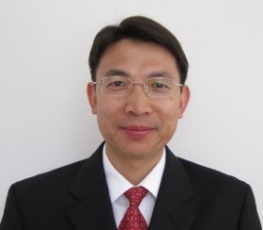The 3D Bioprinting Academic Conference of the National Key Laboratory of Fluid Power and Mechatronics Systems
Academic Report 1:Light-Assisted 3D Bioprinting of Micro- and Nano-scale Functional Biomaterials
Speaker: Prof. Shaochen Chen
Academic Report 2:Three-Dimensional Bioprinting and Evaluation of Process-Induced Cell Injury
Speaker:Prof. Yong Huang
Time:2015.7.10 9:00-12:00
Location:Conference Room, 4th Floor, Hydraulic Old Building, Yuquan Campus
Academic Report 1:Light-Assisted 3D Bioprinting of Micro- and Nano-scale Functional Biomaterials
Shaochen Chen, Ph.D.
Professor of Nano Engineering and Bioengineering Departments
Co-Director, Biomaterials & Tissue Engineering Center, Institute of Engineering in Medicine, University of California, San Diego

The goal of our laboratory is to develop micro- and nano-scale bioprinting techniques for the direct-write of 3D designer scaffolds used for tissue engineering and regenerative medicine. In this webinar, I will present my laboratory’s recent research efforts in femtosecond laser nano-printing and projection 3D bioprinting to create 3D scaffolds using a variety of biomaterials. These 3D biomaterials are functionalized with precise control of micro-architecture, mechanical (e.g. stiffness and Poisson’s ratio), chemical, and biological properties. Design, fabrication, and experimental results will be discussed. Such functional biomaterials allow us to investigate cell-microenvironment interactions at nano- and micro-scales in response to integrated physical and chemical stimuli. From these fundamental studies we can create both in vitro and in vivo tissue models for precision tissue engineering and regenerative medicine.
Brief Bio:
Dr. Shaochen Chen is a Professor in the Nano-Engineering Department and Bioengineering Department at the University of California, San Diego (UCSD). He directs the Biomaterials and Tissue Engineering Center at UCSD. Before joining UCSD, Dr. Chen had been a Professor and a Pearlie D. Henderson Centennial Endowed Faculty Fellow in Engineering in the Mechanical Engineering Department at the University of Texas at Austin from 2001 to 2010. Between 2008 and 2010, he served as the Program Director for the Nanomanufacturing Program in the US National Science Foundation (NSF). Dr. Chen’s primary research interests include: biomaterials and bioprinting, nanomanufacturing, regenerative medicine, tissue engineering, laser and nano-photonics. Dr. Chen has published 101 papers in top journals such as Nature Communications, Nature, Nature Materials, Nano Letters, Biomaterials, Advanced Materials, and 12 book/book chapters.
Among his numerous awards, Dr. Chen received the CAREER award from NSF and Young Investigator award from the Office of Naval Research (ONR). As an active member in his professional community, Dr. Chen is a Fellow of the American Association for the Advancement of Science (AAAS), Fellow of the American Institute for Medical and Biological Engineering (AIMBE), Fellow of the American Society of Mechanical Engineers (ASME), Fellow of the International Society for Optics and Photonics (SPIE), and Fellow of the International Society for Nano-Manufacturing (ISNM).
Academic Report2:Three-Dimensional Bioprinting and Evaluation of Process-Induced Cell Injury
Yong Huang, Department of Mechanical and Aerospace Engineering, University of Florida, Gainesville, FL 32611

Abstract:
Maskless jet-based (including laser- and inkjet-based) three-dimensional (3D) cell printing is a revolutionary advance for printing arbitrary cell patterns as well as creating heterogeneous living constructs. Most importantly, cell printing provides a promising solution to the problem of organ donor shortages by printing 3D tissue/organ constructs for implantation, resulting in what is known as organ printing. Unfortunately, process-induced thermomechanical injury to cells as well as other biomaterials during printing still poses a significant challenge to ensuring a satisfactory post-transfer cell viability. As previous studies show, process-induced thermomechanical loading can dramatically increase the cell mortality rate if printing conditions are not properly selected.
Using a representative laser cell printing technology (modified laser-induced forward transfer) as a jet-based model system, we have been addressing the aforementioned printing-induced cell injury challenge by studying 1) the process-induced cell thermomechanical loading profiles during the cell droplet formation and landing processes, two key processes during cell printing; and 2) the post-transfer cell viability based on the process-induced thermomechanical loading profiles. In this talk, the perspective of ongoing cell printing research is first introduced. Then the modeling of the laser-induced cell droplet formation and successive landing processes and resultant cell mechanical loading is discussed. Finally, the relationship between the post-transfer cell injury/viability and the mechanical loading information is captured through an apoptosis signaling pathway-based modeling approach.
Brief Bio:
Dr. Yong Huang is a professor of Mechanical Engineering, Biomedical Engineering, and Materials Science and Engineering at the University of Florida, Gainesville, Florida. His research interests are two-fold: processing of biological and engineering materials for healthcare/energy applications and understanding of process-induced damage or defect structures. His current research topics include three-dimensional (3D) printing of biological and engineering structures, precision engineering of medical implants and performance evaluation of machined implants, and fabrication of polymeric microspheres / microcapsules / hollow fiber membranes. He served as the Technical Program Chair for the 2010 American Society of Mechanical Engineers International Manufacturing Science and Engineering Conference (MSEC 2010) and the 2012 International Symposium on Flexible Automation (ISFA 2012). He received various awards for his manufacturing research contributions including the ASME Blackall Machine Tool and Gage Award (2005), the SME Outstanding Young Manufacturing Engineer Award (2006), the NSF CAREER Award (2008), and the ASME International Symposium on Flexible Automation Young Investigator Award (2008). He received his Ph.D. in Mechanical Engineering from the Georgia Institute of Technology in 2002 and is a Fellow of ASME.

